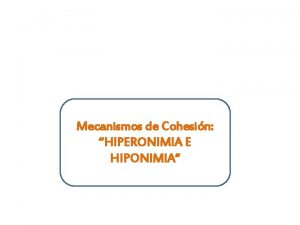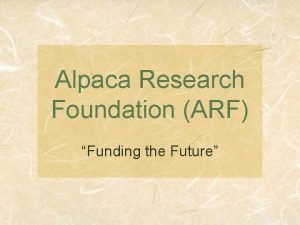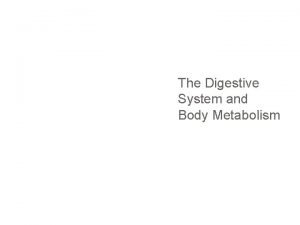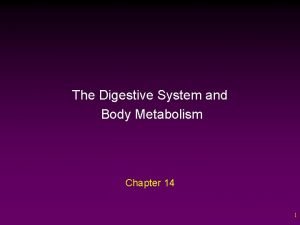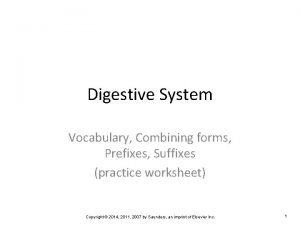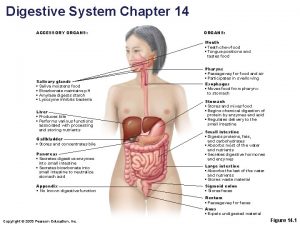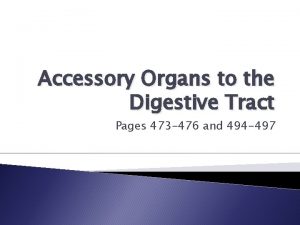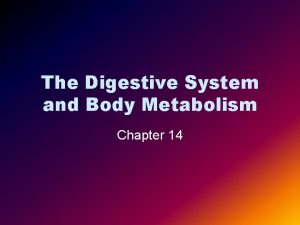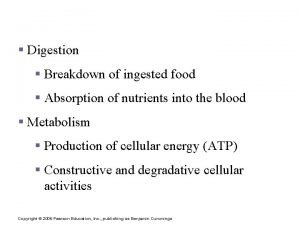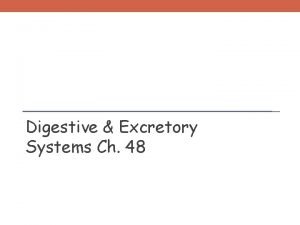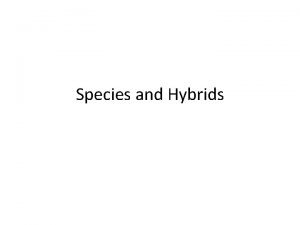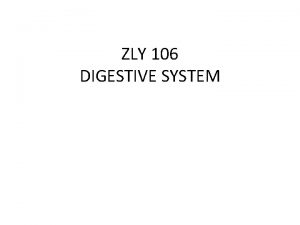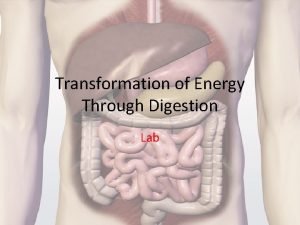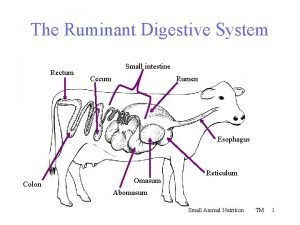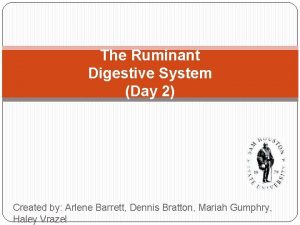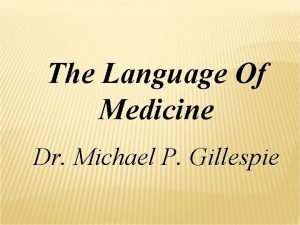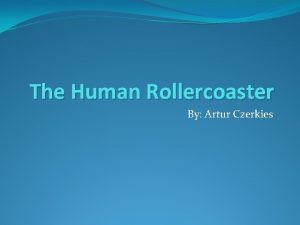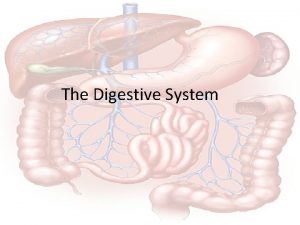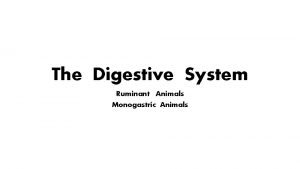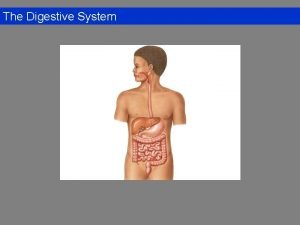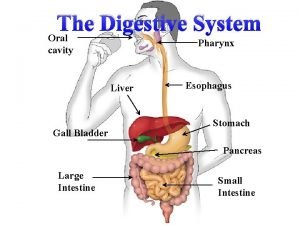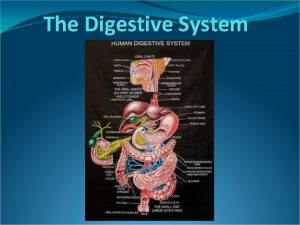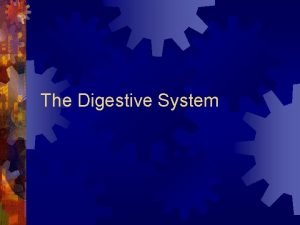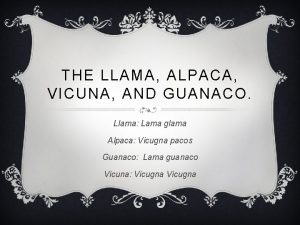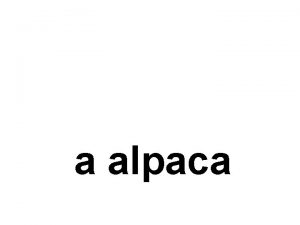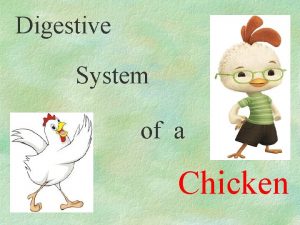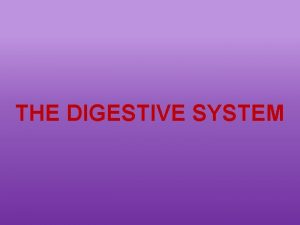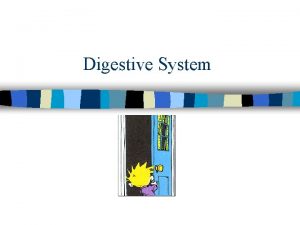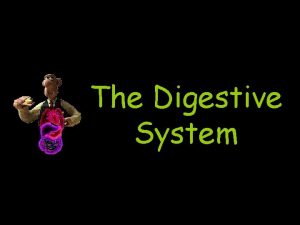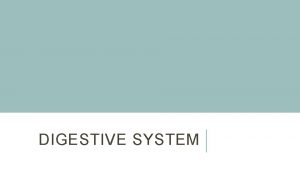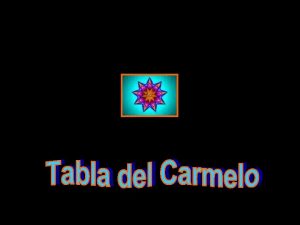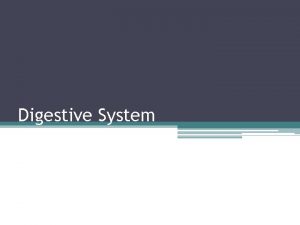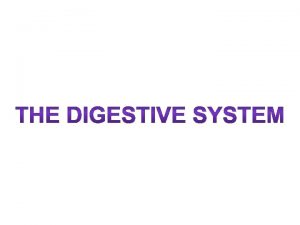The Digestive System of the Llama and Alpaca





























- Slides: 29

The Digestive System of the Llama and Alpaca Dr. Melissa Bruski Dr. Christine Malinowski

Normal Digestive System Unique Characteristics ® Foregut fermentation ® Rumination

The Upper GI Ø Lips Ø Tongue Ø Nares

The Upper GI Ø Teeth Ø Incisors Ø Cheek Teeth Ø Llamas vs. Alpacas

GI “Compartments” Ø C 1 Ø Cranial sac Ø Caudal sac Ø Nomenclature Ø C 2 = C 1, C 2, & C 3

GI “Compartments” Ø C 3 Tubular and glandular Ø p. H changes Ø Permanent & nonpermanent folds Ø Ø Contraction Ø cycles Duration ~2 minutes each

Lower GI Components Ø Adaptions feed to poor Urea recycling Ø Nutrient absorption Ø Ø Overfeeding is dependent on the quality of forage I’m supposed to eat this? ?


Lower GI Components Ø Small intestine Ø Almost 12 m long Cecum is midline running into pelvic inlet (10 cm x 5 cm) Ø Large intestine Ø Spiral w/ many coils Ø Diameter from 5 cm 2 cm Ø Ø Colon

Signs of GI Disease ® anorexia ® dysphagia ® regurgitation ® emesis ® abdominal distension ® ileus ® atony ® colic

Anorexia ® Internal factors ® oral or pharyngeal ulcers ® dental pain ® colic ® gastritis ® External factors ® unsuitable feed ® psychologic ostracism

Dysphagia ® Presents as: drooling of saliva ® retention of feed in the oral cavity ® fetid odor originating from the oral cavity ® gagging/retching ®

Dysphagia ® Due to: pharyngitis/esophagitis ® pharyngeal abscesses or tumors ® esophageal obstruction ® stomach overload ® bloat ® congenital defects ® ® ® choanal atresia cleft soft palate

Abdominal Distension ® Causes: ® excessive fat ® excessive gas ® accumulation of feces ® advanced pregnancy ®A thorough physical will help determine the cause. ® A thorough rectal is not possible.

Ileus ® Dynamic ® spastic ® ® constriction around feces paralytic ® intrinsic disorder of GI motility ® Mechanical peritoneal adhesions ® tumors ® torsions ® internal hernias ®

Ileus ® Post-operatively peritonitis ® ischemia ® overstretching ® ® ® ingesta gas

Regurgitation ® May be voluntary threat ® defense ® ® Esophageal or laryngopharyngeal stimulation ® Passive anesthesia ® recumbancy ®

Emesis ® Due to the elongated soft palate it is very common for ingesta to pass into the nasal cavity. ® ® rhinitis obstruction aspiration pneumonia Causes: ® ® ® C 1 overload gastritis diaphragmatic hernia partial esophageal obstruction poisonous plant ingestion

Stomach Atony ® Usually affects C 1 -C 2 ® Causes: grain overload ® indigestion ® feed changes ® prolonged antibiotic therapy ® spoiled feed ® gastric ulcers ® obstruction ®

Stomach Atony ® Presents as: decreased or complete cessation of food consumption ® loss of body condition ® depression ® may see other GI signs ® ® Diagnosis: ® Lack of C 1 sounds

Stomach Atony ® Treatment: treat primary disease ® supportive care ® ® 3 -5 days of anorexia may cause death of rumen flora so transfaunation may become necessary.

Transfaunation ® 0. 5 -1 L of camelid C 1, or strained sheep or cow, rumen contents is administered to aid in regrowth of rumen flora.

Colic ® very stoic about pain ® signs: teeth grinding ® rolling ® kicking at belly ® anorexia ® depression ® pained facial expression ®

Ulcers ® usually a secondary problem ® most common in the acid secreting distal portion of C 3 and proximal duodenum ® may be partial or complete thickness

Ulcers ® Presents with: decreased food consumption ® intermittent to severe colic ® depression ® ® May also have: secondary pneumonia ® peritonitis ®

Ulcers ® Etiology: unknown ® stress? ? ® ® Diagnosis ® no good pre-mortem test available

Ulcers ® Treatment: Resolve primary problem ® Stress reduction ® Sucralfate ® Omeprazole ® H-2 blockers ® ® ® cimetidine/ranitidine Supportive ® ® fluid therapy prophylactic antibiotics

Selected Bibliography ® Fowler, Murray E. , DVM. Medicine and Surgery of South American Camelids: Llama, Alpaca, Vicuna, Guanaco, 1 st edition. Ames: Iowa State University Press, 1989. ® http: //www. mazuri. com/llamalink. htm ® http: //www. purdyvet. com ® http: //www. merckvetmanual. com ® Johnson, La. Rue W. Update on llama medicine. Philadelphia : Saunders, 1994.

? Questions? ? ?
 Ejemplos de hiponimia e hiperonimia
Ejemplos de hiponimia e hiperonimia Alpaca research foundation
Alpaca research foundation Llama llama red pajama summary
Llama llama red pajama summary Respiratory system circulatory system digestive system
Respiratory system circulatory system digestive system Nervous system and digestive system
Nervous system and digestive system Figure 14-2 digestive system
Figure 14-2 digestive system Digestive system body
Digestive system body Digestion combining form
Digestion combining form Major and accessory organs of the digestive system
Major and accessory organs of the digestive system Figure 14-2 digestive system
Figure 14-2 digestive system Digestive accessory organs
Digestive accessory organs Chapter 14 the digestive system and body metabolism
Chapter 14 the digestive system and body metabolism Art labeling activity: figure 14.1 (3 of 3)
Art labeling activity: figure 14.1 (3 of 3) Animal digestive system parts and functions
Animal digestive system parts and functions Digestive system and body metabolism
Digestive system and body metabolism Digestive and excretory system
Digestive and excretory system Zerbra
Zerbra Deer digestive system
Deer digestive system Monogastric digestive system
Monogastric digestive system What energy transformations take place during digestion?
What energy transformations take place during digestion? Ruminant cecum
Ruminant cecum Ruminant digestive system
Ruminant digestive system Which term means “no sperm or semen are produced”?
Which term means “no sperm or semen are produced”? Digestive system roller coaster project
Digestive system roller coaster project Digestive system facts
Digestive system facts Pig digestive system
Pig digestive system Digestive system histology
Digestive system histology Duodenum function
Duodenum function Introduction to digestive system
Introduction to digestive system Plicae digestive system
Plicae digestive system
